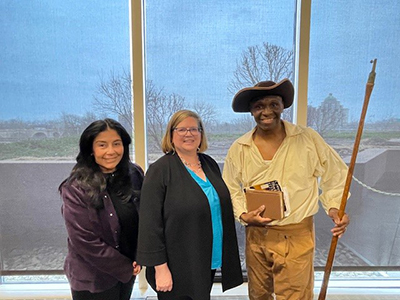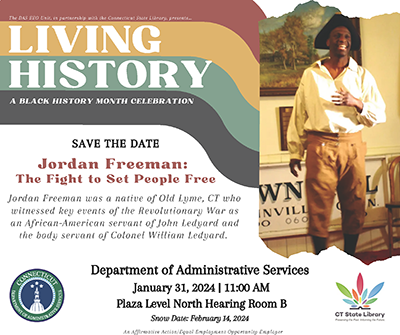DAS Celebrates Black History Month 2024
 |
 |
On January 31, DAS staff gathered to watch the performance of actor Kevin Johnson who reenacted the life of Jordan Freeman a native of Old Lyme, CT who witnessed key events during the Revolutionary War as an African American Servant to John Ledyard and Colonel William Ledyard. The event was organized by the DAS EEO office.
Jordan was born a slave on October 30, 1732, according to historian Kevin Johnson of the Connecticut State Library History Department. While a slave to William Ledyard, Jordan and he had become good friends. In 1776, with the outbreak of war, William was commissioned 1st captain in the Groton militia artillery company. So too, with the start of war, we believe that Ledyard awarded Jordan his freedom.
By 1778, Jordan’s former master, William, was a major, assigned to improve the defenses at New London, Groton, and Stonington; important ports, all from which American privateers sallied to attack British shipping.
Battle of Fort Griswold
On the evening of September 5, 1781, General Benedict Arnold’s fleet of 38 vessels sailed for New London with 1,800 regulars on board. They were to surprise and capture all shipping and, upon Arnold’s digression, destroy warehouses, supplies and anything useful to the American resistance. For Arnold, it became a free pass to basically wipe New London off the map.
Working under Arnold, British Major William Montgomery’s assault on the fort was successful and led to the death of Colonel Ledyard.
Nearing the end, the Americans had run low or were completely out of ammunition. Those choosing to continue the fort’s defense grabbed whatever weapons were available, often left to just the butt of their muskets. The regulars under Montgomery, having gained the bastion against fierce resistance, surged up to the rampart. Montgomery mounted it and as he rallied his men, he was immediately impaled, killed by a ten-foot pike thrust upwards by Jordan Freeman avenging the colonel’s death.
The Battle of Fort Griswold would be the last major engagement of the American Revolution in the north. The last major battle in the deep south would be just two days later, Battle of Eutaw Springs (Sept. 8th) which proved to be the bloodiest of the entire war. And British General Charles Cornwallis’ surrender at Yorktown on October 19, 1781, would occur only 43 days after the slaughter at Fort Griswold, signaling the end of the war.
Information gathered from Revolutionarywarjournal.com

